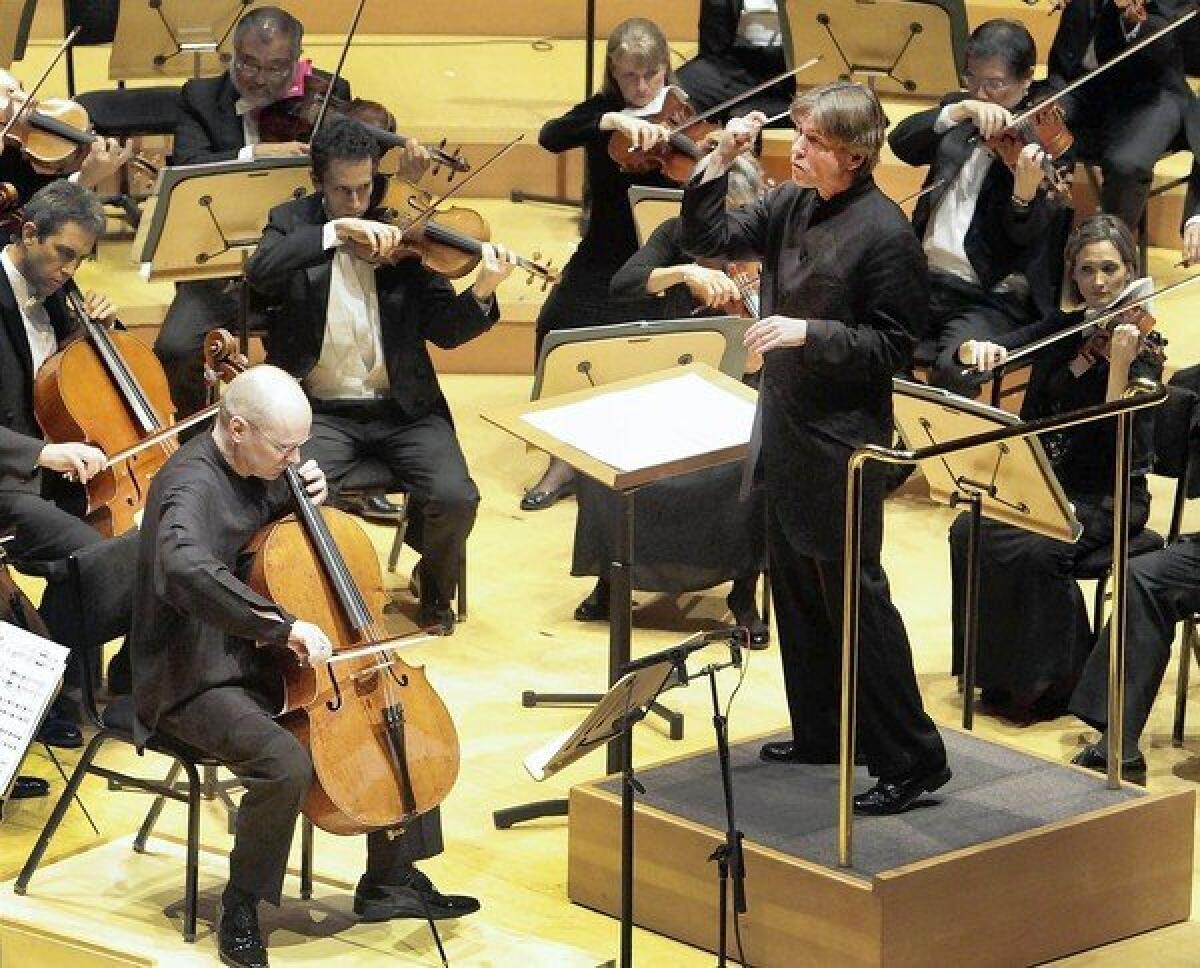Review: Old-home week as Esa-Pekka Salonen returns to Disney Hall

- Share via
The Los Angeles Philharmonic’s monthlong 10th-anniversary celebration of the opening of Walt Disney Concert Hall entered Phase 2 on Friday night. Esa-Pekka Salonen was back. And it was old-home week.
The former music director’s old Finnish friends were on hand for the premiere of Magnus Lindberg’s Cello Concerto No. 2, written for soloist Anssi Karttunen. There were other old friends as well — Debussy and Bartók. Both composers were mainstays of Salonen’s 17 years leading the L.A. Phil.
The playing was superb. The audience was large and acutely enthusiastic. A sense of well-being seemed to pervade the hall. Anyone wanting to understand why Disney has been such a success and the L.A. Phil appears an unusually happy orchestra, at least to the limited extent any orchestra in this day and age is going to be happy, could find out why with this program.
FULL COVERAGE: Walt Disney Concert Hall turns 10
There were no major revelations. Debussy’s “Nocturnes” opened the program; Salonen recorded the piece with the L.A. Phil 20 years ago during his first season as music director. Four years later, he recorded Bartók’s Music for Strings, Percussion and Celesta, which was Friday evening’s last piece.
Salonen also saw to it that both Lindberg and Karttunen became longtime L.A. Phil regulars, and that included the U.S. premiere of Lindberg’s dramatic First Cello Concerto at the Ojai Festival in 1999 and a repeat performance at Dorothy Chandler Pavilion in 2002. Many of Lindberg’s major orchestral scores of the last decade have made it to Disney.
Still, nourishment is found in freshness, and everything Friday felt straight from the farm. The impressionist nocturnal nature of Debussy’s fin-de-siècle score sounded robustly fragrant, music’s evocation of Southern California’s night blooming jasmine. The orchestral texture — be it a solo oboe, violins shimmering in their highest registers or wordless siren calls of a dozen women from the Los Angeles Master Chorale — was fleshy.
Bartók’s score, which uses two string orchestras separated by the percussion, had a powerful, if far more aggressive, physicality as well. It too includes a movement of evocative night music, although of a spooky variety.
CHEAT SHEET: Fall arts preview
But Bartók’s main purpose in his 1936 work was to explore the dynamics of a house divided, which thanks to Washington has come to seem a horrid concept. Here, though, music offers a way out.
Melodic themes are thrown back and forth, while laws, in this case crystalline mathematical structures, remain honored. The percussion and keyboards act as instruments of atmospheric wonder and, when needed, offer a firm hand. The string orchestras find stirring common purpose.
Salonen’s illuminating earlier recordings hold up well. They show progressive sides of both composers who had a major influence in the innovative nature of 20th century music.
But Disney Hall, of which Salonen was the artistic driving force during the venue’s first six years, appears to have given a cerebral conductor permission to become as sensually involved with sound as he has always been intellectually.
The same might be said of Lindberg, who has evolved from an early experimentalist into a more robustly communicative composer, so much so that he has alienated some of his early avant-garde champions. The lyrical Second Cello Concerto is in that vein in that effusive melodic phrases are sometimes underpinned by harmonies and grand orchestral flourishes only a little too modern for Hollywood.
PHOTOS: Arts and culture in pictures by The Times
Even so, writing for Karttunen and Salonen means Lindberg can get away with nothing. Each knows the other almost well enough to be able to read their musical minds. Lindberg also happens to be a pianist with a monster technique, and he and Karttunen sometimes perform together as Dos Coyotes. The new concerto is, in fact, an expansion of Lindberg’s “Santa Fe Project,” which the duo premiered in 2006.
The solo cello writing has a slightly autumnal flavor — maybe too autumnal for a vital 55-year-old composer (he was born three days before Salonen). But this is also brilliantly mature cello writing that takes full advantage of Kartunnen’s natural grace unruffled by even the most extreme virtuosic demands.
Mainly, Lindberg exploits the cellist’s mastery of nuance. The orchestra is of modest size (no percussion). Unlike in his first concerto, where cellist and orchestra are in fierce contrast, Lindberg removes conflict by painting with glowing instrumental colors an exotic sonic landscape around which the cello dives and dances and exults.
You couldn’t tell from a performance that came across as already in the blood of the musicians, but the concerto was a rush job. The L.A. Phil offered Lindberg the commission in June when it became clear that Oliver Knussen’s Cello Concerto, originally announced for this slot, would not be ready in time. Resources for a last-minute commission came from the Esa-Pekka Salonen Commissions Fund, which the L.A. Phil established as a going-away present to the conductor when his tenure ended in 2009 and as a lure to keep him coming back.
So if you are looking for the secret of the L.A. Phil success story, the nourishing of long-term relationships is an excellent place to start.
More to Read
The biggest entertainment stories
Get our big stories about Hollywood, film, television, music, arts, culture and more right in your inbox as soon as they publish.
You may occasionally receive promotional content from the Los Angeles Times.











